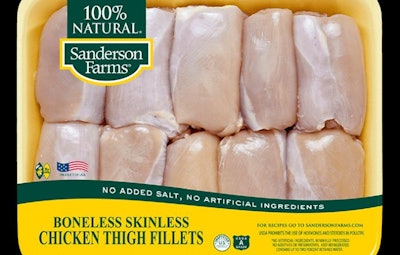
Sanderson Farms on December 19 reported results for the fourth quarter and fiscal year ended October 31, 2019.
Net sales for the fourth quarter of fiscal 2019 were $906.5 million compared with $798.1 million for the same period a year ago. For the quarter, the company reported a net loss of $22.9 million, or $1.05 per share, compared with a net loss of $ 43.2 million, or $1.95 per share, for the fourth quarter of fiscal 2018.
Net sales for fiscal 2019 were $3.440 billion compared with $3.236 billion for fiscal 2018. Net income for the fiscal year totaled $53.3 million, or $2.41 per share, compared with net income of $61.4 million, or $2.70 per share, for last fiscal year.
The results for the quarter and fiscal year ended October 31, 2018, included a charge of $9.6 million, or approximately $0.32 per share net of income taxes, to record live inventories on hand at October 31, 2018, at the lower of cost or net realizable value as required by generally accepted accounting principles. Results for the quarter and fiscal year ended October 31, 2019, include a charge of $2.8 million, or approximately $0.10 cents per share net of income taxes, to record live inventories on hand at October 31, 2019, at the lower of cost or net realizable value.
“The fourth quarter marked the end of the second fiscal year in a row during which market prices for boneless breast meat produced at our plants that process a larger bird for food service customers fell to historically low levels after Labor Day,” said Joe F. Sanderson, Jr., chairman and chief executive officer of Sanderson Farms, Inc. “Similar to fiscal 2018, market conditions weakened significantly during our fourth fiscal quarter of 2019. Despite weakness during our fourth fiscal quarter, overall market prices for poultry moved counter-cyclically higher during November and December, and several factors are expected to support higher market prices for poultry meat as we move into the new calendar year. The protein deficit caused by African swine fever in China and other countries, recently well-publicized chicken sandwich features at quick serve restaurants, and expected higher retail pork and beef prices should all support stronger poultry markets as we move into 2020.
“For the fiscal year, we reported record volume of poultry products sold of 4.53 billion pounds, compared to 4.44 billion pounds in fiscal 2018. Grain prices were slightly higher during fiscal 2019 compared with prices paid in fiscal 2018; however, feed costs in processed flocks were essentially flat per pound, as higher prices paid for feed grain were offset by improved live bird performance.”
According to Sanderson, overall realized prices for poultry products were 3.5 percent higher in fiscal 2019 compared with prices last year. Boneless breast meat market prices averaged 1.0 percent lower in the fourth quarter than the prior-year period. For the full fiscal year, boneless breast meat market prices were 3.4 percent lower compared with fiscal 2018. Jumbo wing market prices averaged $1.73 per pound during the fourth quarter of fiscal 2019, up 19.0 percent from the average of $1.46 per pound during the prior-year period. Jumbo wing market prices averaged $1.72 per pound during the fiscal year, up 19.9 percent from the average of $1.44 per pound for fiscal 2018. The average market price for bulk leg quarters increased approximately 20.6 percent for the fourth fiscal quarter of 2019 compared with the fourth fiscal quarter of 2018, and increased 1.3 percent for fiscal 2019 compared to fiscal 2018. Cash prices for corn during the fourth fiscal quarter increased by 12.8 percent, while soybean meal cash prices were lower by 8.4 percent. For the full fiscal year, cash corn prices were higher by 4.9 percent, while soymeal cash prices were lower by 10.2 percent when compared to fiscal 2018.
“We continue to make progress toward full production at our new poultry complex in Tyler, Texas,” added Sanderson. “The startup in Tyler has gone very well, and we are now processing at approximately 75 percent capacity. We expect to reach full production of 1.3 million head per week at the new plant during our second fiscal quarter of 2020. At full production, that plant will produce approximately 390 million pounds of tray pack product annually for our retail grocery store customers. We also continue to evaluate sites for our next poultry complex, and, as always, look forward to our next phase of growth.
“We are cautiously optimistic as we enter fiscal and calendar 2020. Poultry market prices have moved counter-cyclically higher in November and December, and most expect protein markets to be supported in 2020 by a worldwide protein deficit caused by African swine fever’s impact on Asian pork supplies. In addition, increased promotional activity for chicken sandwiches at quick-serve restaurants and higher expected prices for beef and pork should also support a stronger poultry market as we move into 2020.
“As of October 31, 2019, our balance sheet reflected $1.774 billion in assets, stockholders’ equity of $1.418 billion and net working capital of $365.4 million. We believe our balance sheet provides us with the financial strength not only to support our growth strategy, but also to consistently manage our operations through the cycles that characterize our industry. We deeply appreciate the hard work and dedication to excellence of our employees, growers and everyone associated with our company,” Sanderson concluded.

















